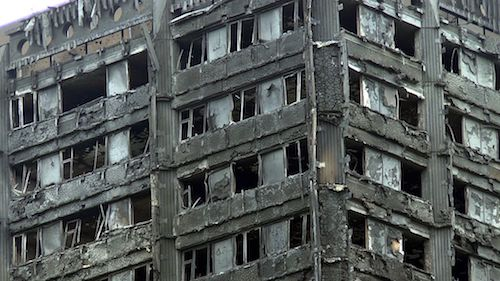UK Officially Bans Combustible Material in High-Rises
TUESDAY, DECEMBER 4, 2018
The United Kingdom announced last week details of its new ban on combustible materials following last year’s fatal Grenfell Tower fire in London that killed more than 70 people.
Housing secretary James Brokenshire announced that under the new legislation, combustible materials will not be permitted in the exterior walls for new buildings more than 18 meters tall. Those buildings include homes, hospitals, residential care facilities, dormitories and other student accommodations.
The Legislation
The ban limits the use of materials to products that achieve a European fire-resistance rating of Class A1 or A2. The announcement also clears up what exactly the government means by “exterior wall.”

 |
| ChiralJon, CC-SA-BY 2.0, via Wikimedia Commons |
|
The United Kingdom announced last week details of its new ban on combustible materials following last year’s fatal Grenfell Tower fire in London that killed more than 70 people. |
The legislation defines an external wall as anything “located within any space forming part of the wall.” It also includes any decoration or finishes applied to external surfaces, windows or doors; roof pitches at an angle of more than 70 degrees; balconies and devices for deflecting sunlight and solar panels.
The policy also prohibits the use of timber materials in the external wall of buildings in those parameters as well, which will stop many project in their tracks, according to the Architects’ Journal, referring to developers using the cross-laminated timber construction method.
The materials ban comes into effect Dec. 21.
“The legislation laid out today is a welcome outcome from a lengthy consultation," said Jane Duncan, Chair of the Royal Institute of British Architecs’ Expert Advisory Group on Fire Safety. "It is of the utmost importance that we get this right—for the victims of such a devastating tragedy and for the future safety of our homes.
"I am pleased that the government [has] taken recommendations on board and broadened the cladding ban to include other high-risk buildings such as hospitals, residential accommodation and care homes. We would like to see other high-risk buildings included, such as hotels and hostels, which are specifically exempted from the legislation."
Brokenshire also announced that local authorities now have the full backing of the government—including financially—to remove cladding from privately owned high-rises. Previously, the government was only aiding public housing.
In July, the U.K. government disclosed that nearly 300 private tower blocks are believed to have Grenfell-style cladding.
Tagged categories: Cladding; Fire; Government; Health and safety; Laws and litigation; Maintenance + Renovation; Regulations; Safety







